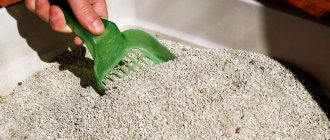Bloody stool is one of the most common problems faced by cats of any age and breed. Under no circumstances should it be left unattended. It is important to contact a veterinarian to find out what is the cause of bloody stools, how to help your pet, and whether possible problems can be prevented in the future.
Read in this article:
- Causes of blood in stool
- Additional symptoms
- What is important to pay attention to?
- Your actions
- Diagnostics
- Blood in a cat's stool: treatment
- Prevention
Causes of blood in stool
The first thing you need to pay attention to is the appearance of the blood. If it is fresh, this indicates that the bleeding began near the anus (for example, the anal sphincter is injured) or in the large intestine.
We draw your attention to the most common reasons why your cat goes to the toilet with blood:
- Eating disorder
- Parasites
- Gastrointestinal diseases
- Foreign bodies
- Neoplasms
- Dysbacteriosis
- Bleeding disorders
- Poisoning with toxic substances
If your pet's diet consists of low-quality dry food, its particles can injure the mucous membranes of the stomach. The likelihood of injury increases if the cat drinks little water. Dry food does not soak, and its sharp ends injure the stomach.
Worms, Giardia, coccidia and other helminths (protozoa) increase capillary permeability and injure the mucous membranes of the stomach. As a result, blood is mixed with the stool, but its volume depends on the number of parasites in the body.
Acute pancreatitis, liver dystrophy, chronic colitis and enteritis are just some of the diseases of the gastrointestinal tract that can cause the appearance of blood clots in the stool. If with an ulcer blood impurities are very noticeable, then with other diseases they are practically invisible.
Most often they enter the gastrointestinal tract during eating or drinking. Foreign objects (for example, pieces of plastic, bones) damage the integrity of soft tissues or cause constipation, in which solid feces slowly pass through the intestines, causing injury.
Passing through the intestine with malignant or benign neoplasms, feces encounter growths. The result is damage to the mucous membranes and the formation of blood impurities in the cat’s stool.
Intestinal bloating, heaviness and grumbling, as well as blood impurities in the stool - these signs are characteristic of dysbiosis that occurs when consuming low-quality or expired products (for example, spoiled milk or sour cream).
If your cat has problems with blood clotting (for example, a deficiency of vitamin K or prothrombin in the body), then even a minor injury can lead to severe bleeding.
Krysid, zoocoumarin and other poisons intended for rodents act on the principle of coagulants. By eating them, the cat's blood clotting is impaired, so a lot of blood appears in the feces. The only way to save your pet is to immediately contact a veterinarian.
Infection with worms
Worm infestation is a fairly common cause of bleeding from the anus in these animals. No cat is immune from parasite infection. Pets who are outdoors and cats whose owners do not care about protecting their four-legged pets from worms are especially at risk. Having penetrated the animal's body, the worms attach to the walls of the small intestine and damage them, which leads to bleeding. Blood comes out along with the stool.
Parasitic infections are dangerous to the health of these animals, but extremely rarely lead to their death. Usually, owners of cats infected with parasites take timely measures to eliminate worms. Their treatment involves the use of antiparasitic veterinary drugs. It is recommended to give the same drugs to pets once every 3 months as a prophylactic measure.
Additional symptoms
Blood in a cat's stool is often not the only symptom. If the cause of bloody stool is an infectious disease or the appearance of neoplasms in the gastrointestinal tract, then your pet will have other accompanying signs.
Among them:
- sudden weight loss,
- vomit,
- diarrhea,
- strong thirst
- sluggish and apathetic state,
- frequent urination (pay attention to the urine: it may also contain small amounts of blood),
- pain in the abdominal area.
Are you observing one or more signs in your pet? Don't hesitate - seek help from a professional veterinarian. He will give the cat an accurate diagnosis and prescribe effective treatment for the disease.
Tumor formations in the intestines
The appearance of blood from the pet's anus is one of the symptoms of neoplasms in the intestines. Such tumors are rarely diagnosed in cats and often have a poor prognosis. The sooner the cat's owner seeks veterinary help, the higher the likelihood of successful treatment of the animal. The causes of this disease are not fully understood. In the course of research, it was possible to establish that representatives of the Siamese breed have a predisposition to intestinal cancer.
Most often, these animals have such types of formations as nutritional lymphoma, intestinal adenocarcinoma and mastocytoma. The disease is accompanied by the following symptoms:
- loss of appetite;
- weight loss;
- nausea and vomiting;
- stomach ache;
- pallor of the mucous membranes;
- lethargy, apathy;
- bloody diarrhea.
What is important to pay attention to?
If your cat is walking around with a lot of blood, then carefully monitor your pet's condition. Pay attention to how often blood is present in his stool: once or regularly (for example, every time he visits the litter box).
It is important to consider whether your pet's behavior changes when visiting the litter box (for example, he meows or moans loudly, his tension and anxiety are noticeable). See how much blood is released: droplets, small clots or large amounts of impurities.
Other points that are important to pay attention to:
- change in appetite
- the presence of impurities in the stool (mucus, hairballs),
- increase in body temperature,
- general condition of the pet.
Note! All this is necessary to answer all the veterinarian’s questions if necessary. Taking into account your information, he will make a diagnosis and determine effective treatment.
Constipation and its treatment in cats
Many times in medical practice there are situations when it turns out that a cat goes “out of need” with blood (sometimes with mucus) due to banal constipation. Hardened feces cause a lot of inconvenience and pain to your pet during defecation. Such stool, having difficulty moving along the intestinal walls, contributes to constant injury to the anus, creating microcracks, tears and ulcerations.
To treat constipation, the veterinarian usually prescribes laxatives and special medications that help the animal get rid of stuck hairballs during bowel movements. Dehydration caused by hot weather and lack of drinking water could also cause the onset and development of constipation in a cat. After implementing the necessary therapeutic measures, the stool used by the animal should return to normal, and the blood present in it should disappear.
Your actions
What to do if your cat has bloody stool? If the blood impurities are small and this condition is not accompanied by other signs (high fever, vomiting), then wait until your pet’s next visit to the litter box.
Contact your veterinarian immediately if:
- Your cat is clearly having difficulty defecating (strains significantly, meows or moans loudly);
- Visits the toilet to defecate too often and her appetite (thirst) has decreased significantly;
- There are bright red blood in the stool more than once, and their size is larger than a speck.
Do not attempt to cure your cat at home - only a qualified veterinarian can make an accurate diagnosis.
Infectious diseases
This problem can be caused by a number of infectious diseases: rotavirus, parvovirus, coronavirus enteritis, which is most often detected in kittens, panleukopenia, salmonellosis, campylobacteriosis, intestinal tuberculosis, colibacillosis, etc. In addition to bleeding from the anus, these diseases are accompanied by other symptoms, such as fever, vomiting, dehydration of the body, loss of appetite, deterioration in general health.
Diagnostics
The key to successful treatment is a thorough diagnosis. The veterinarian conducts a clinical examination, collects anamnesis, and asks questions to the pet owner. If necessary, additional diagnostic methods are prescribed:
- blood analysis,
- stool examination to determine the presence of helminths or protozoa,
- Analysis of urine,
- colonoscopy.
Additionally, an ultrasound or x-ray examination of the abdominal cavity is prescribed to exclude or confirm the possibility of damage to internal organs.
Inflammation of the pancreas
Bleeding from the anus in a cat can be caused by pancreatitis, which develops due to cholelithiasis, pathologies of the duodenum, infections, malnutrition, helminthic infestation, etc. This disease can be recognized by the following signs:
- abdominal pain that gets worse when eating;
- “idle” urge to vomit;
- complete or partial loss of interest in food;
- belching;
- excessive accumulation of gases in the intestines;
- constipation alternating with diarrhea;
- yellowness of the skin and mucous membranes.
In advanced cases, severe disturbances of carbohydrate metabolism join the pathological process. If this happens, it is unlikely that you will be able to avoid developing diabetes.
Blood in a cat's stool: treatment
Having found out why the cat has bloody stool, the specialist draws up a treatment plan. If there are foreign objects in the esophagus or neoplasms are detected, regardless of their nature, only surgery under general anesthesia will help.
If the cause of bloody stools is poisoning, then an antidote with a high content of vitamin K is administered. Additionally, droppers and gastric lavage are prescribed. Maintenance therapy and iron supplements are selected.
For infections, symptomatic treatment is prescribed, and it is important to start it in the first 72 hours to prevent the possibility of complications. The specialist will leave the pet under observation and select medications.
Treatment of hematuria
For the treatment of urocystitis, urolithiasis, nephritis, the following measures and groups of drugs are used:
- Antispasmodics;
- Painkillers;
- Drink plenty of fluids;
- Antibiotics (not always).
In case of urolithiasis, specialized diets and drugs that affect the pH of urine are additionally used.
For nephritis, intravenous infusions and several groups of antimicrobial drugs can be used simultaneously.
If your cat pees blood after an injury, you will need:
- Limited mobility;
- Painkillers;
- Hemostatic;
- Surgery may be required (for example, if the wall is torn).
For diseases of the reproductive system in cats, the following are used:
- Painkillers;
- Antispasmodics;
- In males, antihypertensive drugs that relax the urethra;
- Antibiotics;
- Operation (castration).
If a prompt visit to the veterinarian is not possible
If a cat is peeing with blood, the first thing you need to do is to provide the pet with peace. Set up a bed for him in a quiet, warm place, surround him with care. Place several bowls of fresh water near your pet.
Under no circumstances should you give medications from a human first aid kit without a doctor’s recommendation. First, many drugs cannot be used in animals. Secondly, dosages are completely different for cats and humans. Thirdly, many drugs have contraindications for use.
To properly provide first aid to your pet while you are unable to take it to the clinic, you can consult with a veterinarian online in the Petstory mobile application. The doctor will collect a detailed history, recommend how to help your pet at the moment, tell you what diagnostics should be carried out and what could be the reason for the appearance of red urine in your cat. You can download the application from the link.
Prevention
To prevent the formation of blood in your cat’s feces, it is enough to follow simple rules: provide the correct diet, keep chemicals, poisons and rodent poisons away, and also maintain your pet’s personal hygiene.
First, don’t feed the cat:
- any food from the “human” table,
- pork,
- tomatoes and eggplants,
- foods with a lot of seasonings,
- cereals.
Everything fatty, salty and fried will only harm your pet. Your cat's momentary joy can lead to serious and undesirable consequences in the future, including the appearance of blood in her stool.
Secondly, ensure the hygiene of the animal. It is recommended to accustom your cat to washing its paws and brushing its teeth from an early age. Teeth brushing should be done at least 2 times a week, and paws should be washed after each visit to the street.
So, blood in a cat's stool is a deviation from the norm. It is impossible to independently determine the cause of this condition, so you should not hesitate to contact a professional veterinarian in Moscow. Remember that in many cases your pet’s future health depends on your reaction!
Chronic colitis
If your pet is bleeding from the anus, his colon may be inflamed. The main signs of chronic colitis, characterized by extensive damage to the digestive tract, frequent relapses and a long course:
- unformed stool with a foul odor and inclusions of mucus and blood;
- increased bowel movements and decreased amount of stool;
- rumbling, bloating and abdominal pain.
The danger of this disease is that affected animals usually appear generally healthy: they eat as usual and maintain a constant body weight. When the pathological process worsens, the pet begins to vomit, body temperature rises and weight decreases.
What to do if your cat is peeing blood?
If your cat pees blood, you should immediately contact a veterinarian. If this is not possible, the owner should provide first aid to his pet:
- place the animal in a warm and dry place;
- exclude dry and solid foods from his diet;
- provide free access to drinking water.
It is strictly forbidden to give your cat any medications. Any mistake with the dosage or method of administering the medicine will lead to irreversible consequences. Decoctions of bearberry, parsley or juniper will help reduce inflammation. Remove toxic waste products - horsetail decoction.
How to collect urine for analysis?
You should remove the filler from the tray and wash it thoroughly. After the animal passes the baby, its biological fluid should be collected with a disposable syringe or pipette and poured into a specialized sterile container (sold in veterinary pharmacies). If your cat refuses to go into the litter box without litter, you can fill it with a non-absorbent substrate.
Remember: the optimal volume of urine for analysis is 20 ml. It should be collected no later than 2 – 4 hours before going to the veterinary clinic to obtain an accurate result.











